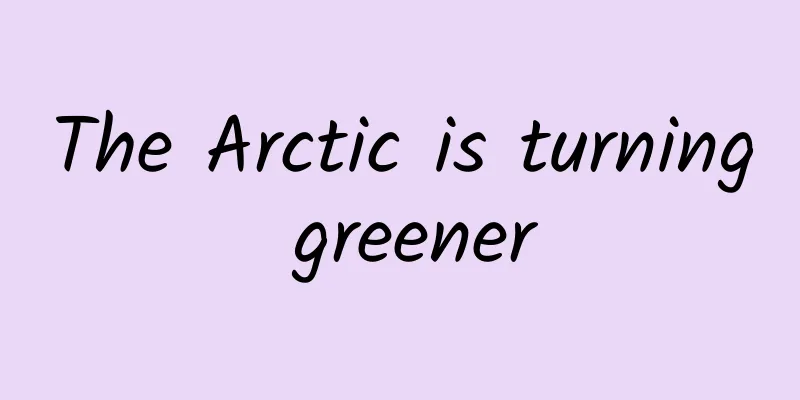The Arctic is turning greener

|
The Arctic region only accounts for about 5% of the world's land area, but it is a huge carbon and methane reservoir, playing an important role in the global climate system. Over the past 50 years, the warming rate in the Arctic has accelerated, causing the originally low tundra vegetation to grow taller and taller, which will profoundly affect the ecosystem function of the region. Recently, a new study by Chinese scientists revealed the origin and formation process of the Arctic flora, which will help protect polar biodiversity. The relevant results were recently published online in the international academic journal Nature Communications. It was once a lush and green place The Arctic is located at a high latitude and is an extremely cold and frozen region. However, in the history of the Earth, it was once a warm and humid place. Geological and paleontological studies have shown that 66 million years ago, the Arctic climate was warm and humid, with lush forests and tropical and subtropical plants such as Lauraceae, Myrtaceae and Podocarpaceae. There are abundant plant fossils in the rock strata, and coal deposits have been found, which fully proves the humid climate characteristics of the Arctic at that time. As the global temperature has cooled since the late Paleogene of the Cenozoic Era, the Arctic ice sheet was finally formed, and the vegetation evolved from forest to the current tundra vegetation. Low plants such as Arctic willow, purple saxifrage and dryas grow on the ground, while tufted saxifrage and stemless flyweed grow in clumps or mats, which are all adaptations of plants to the environment. At present, Chinese scientists have found through comprehensive research on 32 angiosperm groups that the components of the modern Arctic flora can be traced back to the early Late Miocene. Since then, the diversity of alien and indigenous species has increased rapidly at the turn of the Pliocene and Pleistocene, but has dropped sharply since the Mid-Pleistocene Glacial Maximum. The Arctic vegetation has undergone several ups and downs and evolved into the current tundra vegetation. Low-lying vegetation is growing taller and greener Due to the global warming effect, the Arctic's originally very short tundra vegetation has grown taller as the local warming has increased. Not only are the original plants growing taller, but the new plants that have invaded are also taller. Scientists have found that taller plants can more easily "capture" more snow, which helps to insulate the soil beneath the plants, making the soil spend more time freezing in winter, giving the soil more opportunities to release more carbon. The increase in vegetation height is not just happening in a few places in the Arctic, but is happening across the tundra. If taller plants continue to increase at their current rate, plant communities could be 20 to 60 percent taller by the end of the century. Scientists also found that the Arctic land surface area showed a trend of earlier snowmelt and increased vegetation greenness, and the Arctic vegetation greenness and summer warmth index also changed synchronously. From 2002 to 2021, 77.4% of the Arctic continental area increased in greenness, about 5.5 million square kilometers, equivalent to the area of the entire Amazon rainforest. The increase in greenness of Arctic vegetation is mainly related to human activities. The five highest years all occurred after 2017, and the "greening" of vegetation has an accelerating trend. Wetlands and swamps may expand Currently, 30%-50% of the world's "soil carbon" is trapped in the permafrost in the Northern Hemisphere. Any imbalance in the ecosystem caused by climate change will directly lead to the release of large amounts of carbon dioxide and methane. Therefore, the Arctic is now gradually warming. Warming accelerates the carbon cycle, and the Arctic may no longer be a vast ice sheet in the future. In addition, the acceleration of the carbon cycle will also affect the coverage of plants, prompting some organisms to spread faster to other adjacent areas, bringing about a chain reaction of ecological reactions. Scientists have shown that the diversity of Arctic angiosperms comes from multiple biogeographic regions, but about 54% of the immigrants come from western North America, and their migration dynamics run through the entire evolutionary history of the Arctic flora, indicating that there may be a long-term biological dispersal corridor between the Arctic and western North America. Obviously, the current large-scale "greening" of vegetation in the Arctic will profoundly affect the ecosystem function of the region and have an impact on the migration and distribution of wild animals. Significant changes in Arctic vegetation will also exacerbate climate change in the Arctic and the entire Earth. Today, rising temperatures are causing the Arctic's permafrost to begin to melt, and the carbon dioxide released by decomposition enters the atmosphere, making the greenhouse effect more and more serious. In addition, the permafrost in the Arctic region will gradually disappear, causing the soil to become moist, or the wetlands and swamps will expand. Mosses and herbaceous plants often appear in these areas, and the wetlands will become habitats for some aquatic plants and aquatic organisms. Arctic vegetation changes are considered to be the "pointer" and "non-destructive probe" of global climate change. Research on Arctic vegetation changes and trends will deepen human understanding of the global carbon cycle and climate evolution, and will also further understand the far-reaching impacts of changes in Arctic biodiversity. (The author is a researcher at the Nanjing Institute of Geology and Paleontology, Chinese Academy of Sciences, and the honorary curator of the Nanjing Paleontological Museum) |
<<: There are early signs of Alzheimer's disease! Eating these can prevent it early
Recommend
New plans for Mars exploration are being introduced, and a series of new challenges need to be overcome
Recently, my country announced that it will imple...
Table tennis skills teaching video 137 episodes video course Baidu cloud download
Table tennis skills teaching video 137 episodes v...
OPPO App Store CPD Account Recharge Guide
1. Account Recharge Path: Finance – Account Recha...
What are the functions of the Lanzhou check-in mini program? How to create a check-in app on WeChat?
A few days ago, a boss called me and wanted to mak...
Why does the heart suddenly skip a beat sometimes?
References [1] Wang Chun. Chinese scholars discov...
Help Alibaba Pictures calculate whether it is a loss or not after buying Star Cinema for 100 million yuan
The board of directors of Alibaba Pictures announ...
Nokia's 6-inch giant screen phone exposed: equipped with Qualcomm Snapdragon 800 processor
[September 9 news] Recently, the famous technolog...
Prepare for 618! The latest guide to Tencent information flow & QQ advertising!
The biggest e-commerce promotion in the first hal...
Is there a real "tree demon" hiding in the forest? Not only does it scream, it also gives you information.
All living things, when in danger, will convulse,...
Grasshopper "daughter kingdom": only females, can give birth to offspring, and live well | Nature Trumpet
Welcome to the 10th issue of the Nature Trumpet c...
BYD's blade battery receives order from Hyundai Motor and is expected to be supplied overseas next year
According to media reports citing insiders, BYD&#...
The new generation of Huawei Smart Screen V series revealed: comprehensive evolution of audio and video, creating a smart home center
Huawei has been in the smart TV market for nearly...
Wu Yong's "Basic Training of Primary School Writing" Special Teacher's Primary School Writing Teaching
Training course content: The course starts with t...
Taking Double Eleven as a reference, we discuss the necessity of brands grabbing sales through all channels
According to the "2017 China Social E-commer...
40 kilometers above the sky, scientists want to release a "balloon" to serve as an observatory
Produced by: Science Popularization China Author:...
![[Special Topic] Why are WeChat red envelopes so popular? Here are some unknown facts behind it!](/upload/images/67ebee61b99a4.webp)








